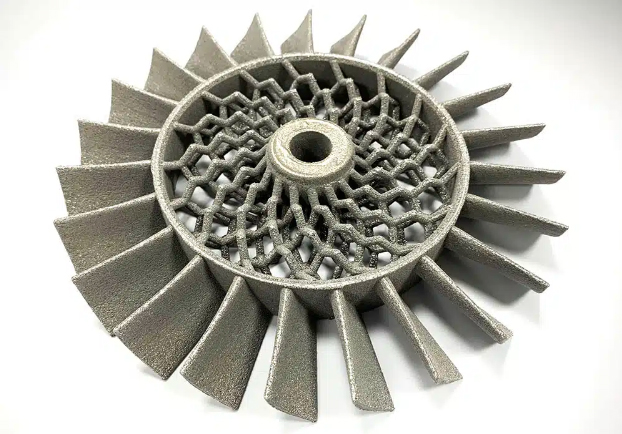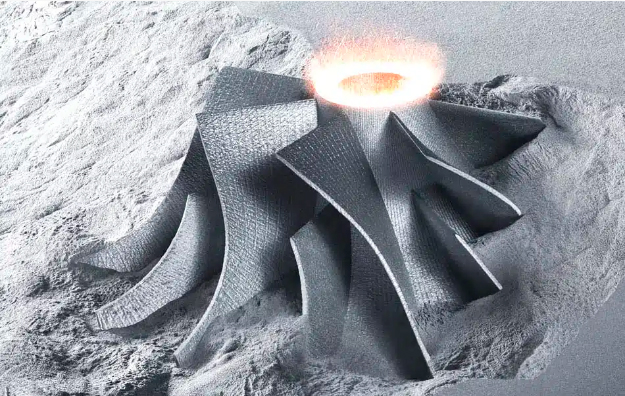Metal injection molding (MIM) and metal 3D printing are very competitive metal manufacturing technologies. These two metal processing methods are cost-effective for the production of small and complex metal parts. Otherwise, these two metal manufacturing methods have unique advantages and limitations.
Metal Injection Molding is a core metal processing technology used to produce small parts with a variety of material options.MIM operations offer reliable high-volume production capabilities and excellent material properties.
MIM is applied to the production of parts in many industries, such as medical, automobile, electronics and general industry. Due to the large investment in MIM tools, once the amortization exceeds millions of units, it is also reasonable to apply MIM technology in the economic aspect.

Metal injection molding (MIM) technology combines plastic injection molding with powder metallurgy to produce metal mesh parts with complex geometry. The MIM process includes four main stages - raw material mixing, injection molding, degreasing and sintering.
Fine metal powder is combined with thermoplastic materials and wax adhesives, and then granulated into small particles
These raw materials are heated and injected in ordinary injection molding machines, and then the required shapes are formed in different mold cavities.
After forming, the adhesive material will be removed from the formed parts in the degreasing furnace, thus forming brown parts.
Move the brown part into the sintering furnace, and then heat it to a relatively low temperature to burn off the remaining adhesive. Finally, these parts are sintered at a high temperature close to the metal melting point, and reach the density of the final sintered parts.
Engineers choose MIM technology to produce small parts with complex structures, especially those parts that are difficult to effectively manufacture through other metal processing processes. Because only one mold is used in the whole MIM manufacturing process, it ensures high repeatability and makes the parts have uniform shape and strength.
MIM parts are widely used in major commercial and industrial sectors from automobile, electronics to medical, aerospace, etc.
Metal injection molding is an effective method for mass production. The finished MIM part has a relatively strong smooth surface finish. MIM technology is compatible with a variety of metal materials, most of which are steel. MIM material is in powder form and suitable for sintering.
Because MIM technology requires precise molds to produce MIM parts, there are many limitations. The average cost of MIM mold is 5000 to 10000 US dollars, which is very expensive for small batch production. Generally, MIM has financial significance only for products with an annual output of more than 50,000 and a long-term production life cycle.
In addition, we need to consider various design challenges in the MIM design process. Mold design is difficult to alternate, and the shape is still very limited. For example:
The large overhang should be eliminated because it needs to be ejected from the cavity.
Wall thickness is another design challenge in the degreasing process. Too thick walls are difficult to degrease, while too thin walls are easy to collapse.
Metal 3D printing technology includes two typical methods: metal powder bed fusion and metal binder jet (MBJ).

Although there are different methods for metal 3D printing, the common method is to use high-energy methods to produce parts from metal powders.
In this process, the inert gas is pretreated in the chamber to minimize oxidation during melting or sintering. Lay a thin layer of metal powder on the construction platform, and then the laser system will melt the powder in small pieces. Repeat these powder diffusion and melting steps until the final part is completely formed. After the parts are cooled, the excess metal powder is removed. The part shall be stress relieved and removed from the construction plate, and heat treated as required.
The powder bed fusion process is an ideal choice for industrial applications with high performance engineering requirements. Common applications include jet engines, medical equipment, turbine blades, and powder generators. These 3D printing methods are compatible with more and more metal alloys, even precious metals such as gold and platinum.
There are other metal 3D printing methods, such as metal adhesive spraying and metal extrusion. They are better suited for applications with fewer regulations and critical performance.
Metal 3D printing is specially used for metal parts with specific properties, such as high strength and durability, chemical resistance, and unique design features. It provides engineers with more design freedom. With the elimination of molds, it is easy to update the design in the computer. Any complex design will not increase the production cost.
Metal 3D printing has its own challenges, and its building size is limited by strict manufacturing conditions and process control. The cost of an industrial 3D printer is millions, which does not include the cost of materials.
Metal injection molding (MIM) and metal 3D printing have similar production capabilities in durable and high-quality metal parts. Both technologies provide equipment manufacturers (DM) and their contact manufacturers (CM) with alternatives to traditional machining, die casting, investment casting, and powder metallurgy methods.

MIM is always the first choice for mass production of small and complex parts. However, high cost tools are the key factor limiting MIM technology. In addition, any feature changes in the MIM design will result in further mold modifications. This also leads to additional costs.
Metal 3D printing eliminates the need for molds, but the cost of each part is still high. For example, the cost of a DMLS machine will exceed $1 million, and the cost of materials per kilogram will be as high as $330.
Metal injection molding requires molds to create green blanks. Compared with metal 3D printing, there are more geometric limitations. MIM molds are well suited for highly automated processes, which ensure mass production during the molding process.
On the other hand, metal 3D printing builds parts on a layer by layer basis, which means that any new design is possible. In addition, the additional complexity will not result in additional tooling and production costs.
Although metal 3D printing has no limit in geometric design and mold processing, its high energy consumption and machine investment lead to high cost of each part. Compared with metal injection molding, conventional metal 3D printing methods: SLM, DMLS and EBM have no price advantage. In this case, ordinary metal 3D printing is only applicable to small metal parts with complex geometry, which is difficult to create by injection molding.
Comparison table
Metal injection molding | Metal 3D printing |
40 years of technology | 20 years of technology |
The optimal output exceeds 20000/year | The optimal output is less than 20000/year |
$50000 to $100000 mold cost | No mold required |
Individual components per mold | No additional cost for updating |
Limited geometry | Freedom of design |
Best suited for part design without change | The most suitable part design for frequent modification |
Higher tolerances and stable production | Normal tolerances in production |
However, metal binder jet (BJT) is a new low-cost bonding and sintering technology in metal 3D printing. This rapid process method provides toolless mass production and can utilize existing MIM expertise and equipment. With the development of metal binder injection technology, it is becoming an important supplement to metal injection molding. BJT has very low cost and can compete directly with MIM.
Although metal binder jet (MBJ) reduces the price of each piece of metal 3D printing, its competitive advantage is not as good as metal injection molding (MIM). Once the production is much higher than the prototype, but lower than the breakeven cost of the MIM tool, MBJ is a good choice. Generally, once the annual output is less than 20000 pieces, metal adhesive spraying is more cost-effective. Otherwise, the annual output of MIM technology is unlimited, and the unit price will be greatly reduced for mass production.
It is very important to pay attention to the tolerance of metal parts in MIM manufacturing. Metal injection molding can provide a more stable tolerance of ±0.3% in batch production, while MBJ can only provide a nominal tolerance of ±0.5%. On the other hand, the metal adhesive jet is manufactured as a metal additive, which has higher design flexibility. It can create specific geometry, which is impossible for MIM.
Contact: Cindy Wang
Phone: +86 19916725892
Tel: 0512-55128901
Email: [email protected]
Add: No.6 Huxiang Road, Kunshan development Zone, JiangsuShanghai Branch: No. 398 Guiyang Rd, Yangpu District, Shanghai, China